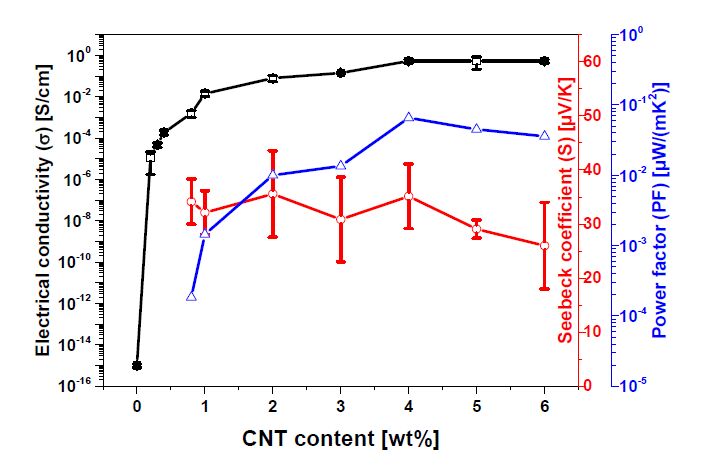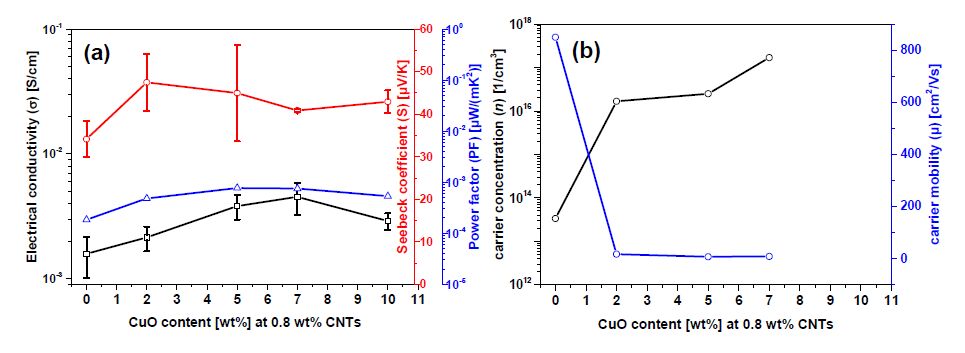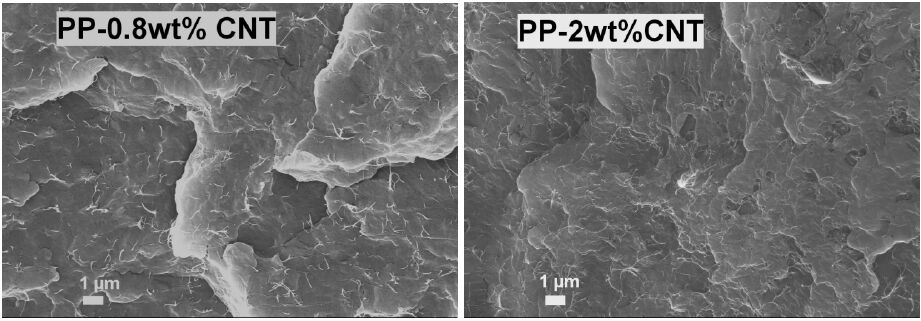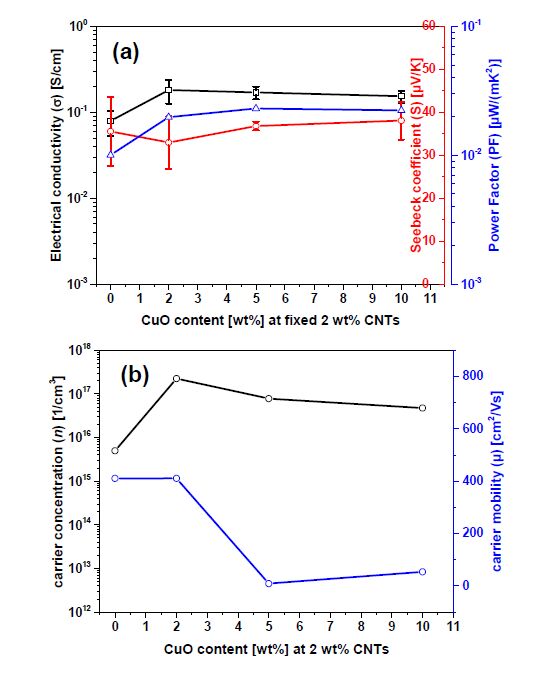Flexible thermoelectric materials are prepared by melt mixing technique, which can be easily scaled up to industrial level. Hybrid filler systems of carbon nanotubes (CNTs) and copper oxide (CuO), which are environmental friendly materials and contain abundant earth elements, are melt mixed into a thermoplastic matrix, namely polypropylene (PP). With the CNT addition, an electrical network could be built up inside the insulating PP for effective charge transport. The effect of CuO addition is determined by the corresponding CNT concentration. At high CNT concentration, largely above the percolation threshold (φc, ca. 0.1 wt%), the change in the TE properties is small. In contrast, at CNT concentration close to φc, the co-addition of CuO could simultaneously increase the electrical conductivity and Seebeck coefficient. With 5 wt% CuO and 0.8 wt% CNTs where a loose percolated network is formed, the Seebeck coefficient was increased from 34.1 µV/K to 45 µV/K while the electrical conductivity was from 1.6 × 10−3 S/cm to 3.8 × 10−3 S/cm, leading to a power factor of 9.6 × 10−4 µW/mK2 (cf. 1.8 × 10−4 µW/mK2 for the composite with only 0.8 wt% CNTs).
1.
Introduction
Throughout the paper, we work over an algebraically closed field k of characteristic zero. Let C be a nonsingular projective curve of genus g≥0, and L be a very ample line bundle on C. The complete linear system |L| embeds C into a projective space Pr:=P(H0(C,L)). For an integer k≥0, the k-th secant variety
of C in Pr is the Zariski closure of the union of (k+1)-secant k-planes to C.
Assume that degL≥2g+2k+1. Then the k-th secant variety Σk can be defined by using the secant sheaf Ek+1,L and the secant bundle Bk(L) as follows. Denote by Cm the m-th symmetric product of C. Let
be the morphism sending (ξ,x) to ξ+x, and p:Ck×C→C the projection to C. The secant sheaf Ek+1,L on Ck+1 associated to L is defined by
which is a locally free sheaf of rank k+1. Notice that the fiber of Ek+1,L over ξ∈Ck+1 can be identified with H0(ξ,L|ξ). The secant bundle of k-planes over Ck+1 is
equipped with the natural projection πk:Bk(L)→Ck+1. We say that a line bundle L on a variety X separates m+1 points if the natural restriction map H0(X,L)→H0(ξ,L|ξ) is surjective for any effective zero-cycle ξ⊆X with length(ξ)=m+1. Notice that a line bundle L is globally generated if and only if L separates 1 point, and L is very ample if and only if L separates 2 points. Since degL≥2g+k, it follows from Riemann–Roch that L separates k+1 points. Then the tautological bundle OBk(L)(1) is globally generated. We have natural identifications
and therefore, the complete linear system |OBk(L)(1)| induces a morphism
The k-th secant variety Σk=Σk(C,L) of C in Pr can be defined to be the image βk(Bk(L)). Bertram proved that βk:Bk(L)→Σk is a resolution of singularities (see [1,Section 1]).
It is clear that there are natural inclusions
The preimage of Σk−1 under the morphism βk is actually a divisor on Bk(L). Thus there exits a natural morphism from Bk(L) to the blowup of Σk along Σk−1. Vermeire proved that B1(L) is indeed the blowup of Σ1 along Σ0=C ([3,Theorem 3.9]). In the recent work [2], we showed that Bk(L) is the normalization of the blowup of Σk along Σk−1 ([2,Proposition 5.13]), and raised the problem asking whether Bk(L) is indeed the blowup itself ([2,Problem 6.1]). The purpose of this paper is to give an affirmative answer to this problem by proving the following:
Theorem 1.1. Let C be a nonsingular projective curve of genus g, and L be a line bundle on C. If degL≥2g+2k+1 for an integer k≥1, then the morphism βk:Bk(L)→Σk(C,L) is the blowup of Σk(C,L) along Σk−1(C,L).
To prove the theorem, we utilize several line bundles defined on symmetric products of the curve. Let us recall the definitions here and refer the reader to [2] for further details. Let
be the (k+1)-fold ordinary product of the curve C, and pi:Ck+1→C be the projection to the i-th component. The symmetric group Sk+1 acts on p∗1L⊗⋯⊗p∗k+1L in a natural way: a permutation μ∈Sk sends a local section s1⊗⋯⊗sk+1 to sμ(1)⊗⋯⊗sμ(k+1). Then p∗1L⊗⋯⊗p∗k+1L is invariant under the action of Sk+1, so it descends to a line bundle Tk+1(L) on the symmetric product Ck+1 via the quotient map q:Ck+1→Ck+1. We have q∗Tk+1(L)=p∗1L⊗⋯⊗p∗k+1L. Define a divisor δk+1 on Ck+1 such that the associated line bundle OCk+1(δk+1)=det(σk+1,∗(OCk×C))∗. Let
be a line bundle on Ck+1. When k=0, we use the convention that T1(L)=E1,L=L and δ1=0.
The main ingredient in the proof of Theorem 1.1 is to study the positivity of the line bundle Ak+1,L. Some partial results and their geometric consequences have been discussed in [2,Lemma 5.12 and Proposition 5.13]. Along this direction, we establish the following proposition to give a full picture in a general result describing the positivity of the line bundle Ak+1,L. This may be of independent interest.
Proposition 1.2. Let C be a nonsingular projective curve of genus g, and L be a line bundle on C. If degL≥2g+2k+ℓ for integers k,ℓ≥0, then the line bundle Ak+1,L on Ck+1 separates ℓ+1 points.
In particular, if degL≥2g+2k, then Ak+1,L is globally generated, and if degL≥2g+2k+1, then Ak+1,L is very ample.
2.
Proof of the main theorem
In this section, we prove Theorem 1.1. We begin with showing Proposition 1.2.
Proof of Proposition 1.2. We proceed by induction on k and ℓ. If k=0, then A1,L=L and degL≥2g+ℓ. It immediately follows from Riemann–Roch that L separates ℓ+1 points. If ℓ=0, then degL≥2g+2k. By [2,Lemma 5.12], Ak+1,L separates 1 point.
Assume that k≥1 and ℓ≥1. Let z be a length ℓ+1 zero-dimensional subscheme of Ck+1. We aim to show that the natural restriction map
is surjective. We can choose a point p∈C such that Xp contains a point in the support of z, where Xp is the divisor on Ck+1 defined by the image of the morphism Ck→Ck+1 sending ξ to ξ+p. Let y:=z∩Xp be the scheme-theoretic intersection, and Ix:=(Iz:IXp), which defines a subscheme x of z in Ck+1, where Iz and IXp are ideal sheaves of z and Xp in Ck+1, respectively. We have the following commutative diagram
where all rows and columns are short exact sequences. By tensoring with Ak+1,L and taking the global sections of last two rows, we obtain the commutative diagram with exact sequences
in which we use the fact that H1(Ak+1,L(−Xp))=0 (see the proof of [2,Lemma 5.12]). Note that Ak+1,L(−Xp)=Ak+1,L(−p) and Ak+1,L|Xp≅Ak,L(−2p), where we identify Xp=Ck.
Since length(y)≤length(z)=ℓ+1 and degL(−2p)≥2g+2(k−1)+ℓ, the induction hypothesis on k implies that ry,k,L(−2p) is surjective. On the other hand, if x=∅, which means that z is a subscheme of Xp, then trivially rx,k+1,L(−p) is surjective. Otherwise, suppose that x≠∅. By the choice of Xp, we know that y is not empty, and therefore, we have length(x)≤length(z)−1=ℓ. Now, degL(−p)≥2g+2k+(ℓ−1), so the induction hypothesis on ℓ implies that L(−p) separates ℓ points. In particular, rx,k+1,L(−p) is surjective. Hence rz,k+1,L is surjective as desired.
Lemma 2.1. Let φ:X→Y be a finite surjective morphism between two varieties. If φ−1(q) is scheme theoretically a reduced point for each closed point q∈Y, then φ is an isomorphism.
Proof. Note that φ is proper, injective, and unramifield. Then it is indeed a classical result that φ is an isomorphism. Here we give a short proof for reader's convenience. The problem is local. We may assume that X=SpecB and Y=SpecA for some rings A,B. We may regard A as a subring of B. For any q∈Y, let p:=φ−1(q)∈X. It is enough to show that the localizations A′:=Amq and B′:=Bmp are isomorphic. Let m′q,m′p be the maximal ideals of the local rings A′,B′, respectively. The assumption says that m′qB′=m′p. We have
By Nakayama lemma, we obtain B′/A′=0.
We keep using the notations used in the introduction. Recall that C is a nonsingular projective curve of genus g≥0, and L is a very ample line bundle on C. Consider ξk∈Ck and x∈C, and let ξ:=ξk+x∈Ck+1. The divisor ξk spans a k-secant (k−1)-plane P(H0(ξk,L|ξk)) to C in P(H0(C,L)), and it is naturally embedded in the (k+1)-secant k-plane P(H0(ξ,L|ξ)) spanned by ξ. This observation naturally induces a morphism
To see it in details, we refer to [1,p.432,line –5]. We define the relative secant variety Z=Zk−1 of (k−1)-planes in Bk(L) to be the image of the morphism αk,1. The relative secant variety Z is a divisor in the secant bundle Bk(L), and it is the preimage of (k−1)-th secant variety Σk−1 under the morphism βk. It plays the role of transferring the codimension two situation (Σk,Σk−1) into the codimension one situation (Bk(L),Z). We collect several properties of Z.
Proposition 2.2. ([2,Proposition 3.15,Theorem 5.2,and Proposition 5.13]) Recall the situation described in the diagram
Let H be the pull back of a hyperplane divisor of Pr by βk, and let IΣk−1|Σk be the ideal sheaf on Σk defining the subvariety Σk−1. Then one has
1. OBk(L)((k+1)H−Z)=π∗kAk+1,L.
2. Riβk,∗OBk(L)(−Z)={IΣk−1|Σkifi=00ifi>0.
3. IΣk−1|Σk⋅OBk(L)=OBk(L)(−Z).
As a direct consequence of the above proposition, we have an identification
We are now ready to give the proof of Theorem 1.1.
Proof of Theorem 1.1. Let
be the blowup of Σk along Σk−1 with exceptional divisor E. As IΣk−1|Σk⋅OBk(L)=OBk(L)(−Z) (see Proposition 2.2), there exists a morphism α from Bk(L) to the blowup ˜Σk fitting into the following commutative diagram
We shall show that α is an isomorphism.
Write V:=H0(Σk,IΣk−1|Σk(k+1)). As proved in [2,Theorem 5.2], IΣk−1|Σk(k+1) is globally generated by V. This particularly implies that on the blowup ˜Σk one has a surjective morphism V⊗O˜Σk→b∗OΣk(k+1)(−E), which induces a morphism
On the other hand, one has an identification V=H0(Ck+1,Ak+1,L) by Proposition 2.2. Recall from Proposition 1.2 that Ak+1,L is very ample. So the complete linear system |V|=|Ak+1,L| on Ck+1 induces an embedding
Also note that α∗(b∗OΣk(k+1)(−E))=β∗kOΣk(k+1)(−Z)=π∗kAk+1,L by Proposition 2.2. Hence we obtain the following commutative diagram
Take an arbitrary closed point x∈˜Σk, and consider its image x′:=b(x) on Σk. There is a nonnegative integer m≤k such that x′∈Σm∖Σm−1⊆Σk. In addition, the point x′ uniquely determines a degree m+1 divisor ξm+1,x′ on C in such a way that ξm+1,x′=Λ∩C, where Λ is a unique (m+1)-secant m-plane to C with x′∈Λ (see [2,Definition 3.12]). By [2,Proposition 3.13], β−1k(x′)≅Ck−m and πk(β−1k(x′))=ξm+1,x′+Ck−m⊆Ck+1. Consider also x″:=γ(x) which lies in the image of ψ. As ψ is an embedding, we may think x″ as a point of Ck+1. Now, through forming fiber products, we see scheme-theoretically
However, the restriction of the morphism πk on β−1k(x′) gives an embedding of Ck−m into Ck+1. This suggests that π−1k(x″)∩β−1k(x′) is indeed a single reduced point, and so is α−1(x). Finally by Lemma 2.1, α is an isomorphism as desired.


















 DownLoad:
DownLoad: